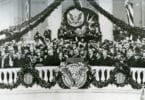Early Life and Background
Rutherford Birchard Hayes was born in Delaware, Ohio on October 4, 1822. He was the fifth child of Rutherford Hayes Jr. and Sophia Birchard Hayes. Unfortunately, his father died ten weeks before Rutherford was born, leaving his mother to raise him and his siblings. Despite the hardships, Sophia Hayes was a determined and resourceful woman who ensured her children received a good education.
Hayes’ early education occurred in common schools and Norwalk Academy in Ohio. He later attended Kenyon College, where he graduated as valedictorian in 1842. Following college, Hayes studied law at Harvard Law School and graduated in 1845. He was admitted to the bar the same year and began practicing law in Lower Sandusky (now Fremont), Ohio.
Early Career and Marriage
Hayes established a successful law practice and became involved in local politics. In 1852, he married Lucy Ware Webb, a well-educated and socially active woman from Chillicothe, Ohio. Lucy was deeply committed to social causes, including temperance and the abolition of slavery. She significantly influenced Hayes and was an active partner in his public life. The couple had eight children, five of whom survived to adulthood: Birchard, Webb, Rutherford Platt, Joseph, and Fanny.
Civil War Service
With the outbreak of the Civil War, Hayes joined the Union Army in 1861, initially as a major in the 23rd Ohio Volunteer Infantry. He served with distinction, participating in several key battles, including the Battle of South Mountain, the Battle of Antietam, and the Siege of Petersburg. Hayes was wounded multiple times and became a major general by the war’s end. His military service earned him a reputation for bravery and leadership, which bolstered his political career.
Early Political Career
After the Civil War, Hayes resumed his law practice and entered politics. He was elected to the U.S. House of Representatives in 1864, serving two terms. During his time in Congress, Hayes staunch supporter of Reconstruction policies and civil rights for freed slaves. In 1867, he was elected governor of Ohio, serving three terms (1868-1872, 1876-1877). As governor, Hayes promoted educational reform, prison reform, and economic development.
The Election of 1876
Hayes was the Republican nominee for president in the highly contentious election of 1876. His opponent was Democrat Samuel J. Tilden. The election results were fiercely disputed, with both parties claiming victory in several states. The electoral vote was so close that it led to a constitutional crisis.
To resolve the impasse, Congress established the Electoral Commission, a bipartisan panel tasked with determining the rightful winner. The commission ultimately awarded all disputed electoral votes to Hayes, resulting in a final count of 185 to 184 in his favor. This decision was part of the Compromise of 1877, which effectively ended Reconstruction by promising to withdraw federal troops from the South.
Presidency (1877-1881)
Ending Reconstruction
Hayes’ presidency began under the shadow of the disputed election and the Compromise of 1877. One of his first acts as president was to withdraw federal troops from the remaining occupied Southern states, effectively ending Reconstruction. While this move was intended to promote national unity and reconciliation, it also led to the disenfranchisement and oppression of African Americans in the South as white supremacist groups regained control.
Civil Service Reform
Hayes was a strong advocate for civil service reform. He sought to reduce corruption and patronage in government appointments, implementing merit-based systems and competitive exams for federal positions. His efforts laid the groundwork for future civil service reforms, including the Pendleton Civil Service Reform Act of 1883.
Economic and Domestic Policies
Hayes faced several economic challenges during his presidency, including the aftermath of the Panic of 1873. He supported measures to stabilize the economy, such as the resumption of the gold standard through the Specie Payment Resumption Act of 1875, which took effect in 1879. Hayes also vetoed the Bland-Allison Act, which called for the free coinage of silver, although Congress overrode his veto.
On the domestic front, Hayes advocated for educational improvements and sought to protect the rights of Native Americans. He appointed Carl Schurz as Secretary of the Interior, who implemented policies aimed at reforming the Bureau of Indian Affairs and reducing corruption.
Personal Life and Character
Hayes’ personal life was marked by his strong partnership with his wife, Lucy. Lucy Hayes was the first First Lady to have a college degree and a prominent advocate for social causes, including temperance. Her influence earned her the nickname “Lemonade Lucy” due to her support for banning alcohol from the White House. Together, they were known for their warm hospitality and commitment to public service.
Hayes was known for his integrity, honesty, and commitment to principle. He refused to seek a second term, adhering to his pledge to serve only one term as president. His decision to retire from politics after his presidency was in keeping with his belief in the importance of citizen leadership and his desire to return to private life.
Post-Presidency
After leaving the White House in 1881, Hayes retired to his estate, Spiegel Grove, in Fremont, Ohio. He remained active in public affairs, advocating for educational reform and veterans’ welfare. Hayes served as a trustee of Ohio State University and supported efforts to establish libraries and schools. He also worked to promote racial equality and improve conditions for African Americans.
Hayes continued to write and speak on issues of national importance until his death on January 17, 1893. He was buried at Spiegel Grove, which later became the Rutherford B. Hayes Presidential Center, preserving his legacy and contributions to American history.
Legacy and Impact
Rutherford B. Hayes’ presidency is often remembered for its role in ending Reconstruction and its efforts to reform the civil service. While his decision to withdraw federal troops from the South led to negative consequences for African Americans, his commitment to civil service reform and his principled approach to governance left a lasting impact.
Hayes’ dedication to education, veterans’ welfare, and racial equality continued to influence his post-presidential activities. His legacy reflects his belief in integrity, public service, and the importance of national unity.
Interesting Aspects of Hayes’ Presidency
The End of Reconstruction
The Compromise of 1877, which led to Hayes’ election, marked the end of Reconstruction. Hayes’ withdrawal of federal troops from the South allowed white supremacist groups to regain power and disenfranchise African Americans, leading to decades of segregation and discrimination. This decision remains one of the most controversial aspects of his presidency.
First Telephone in the White House
Hayes was the first president to install a telephone in the White House. The device, installed in 1879, symbolized technological advancement and modernization. Hayes’ phone number was “1,” highlighting the novelty of the technology at the time.
Conclusion
Rutherford B. Hayes’ life and presidency provide a nuanced portrait of a leader who navigated a complex and transitional period in American history. Hayes’ story reflects his commitment to public service, integrity, and reform from his early life and military service to his presidency and post-presidential activities.
While his presidency faced significant challenges and controversies, particularly regarding Reconstruction and civil rights, Hayes’ efforts to promote civil service reform and improve education and veterans’ welfare left a lasting impact. His legacy is a testament to the complexities and challenges of leadership during a transformative era in American history.
Recommended Books on Rutherford B. Hayes
“Rutherford B. Hayes: Warrior and President” by Ari Hoogenboom
This comprehensive biography by Ari Hoogenboom offers a detailed and balanced account of Hayes’ life, from his early years and military service to his presidency and beyond.
Part of The American Presidents Series, this concise biography by Hans L. Trefousse provides an accessible overview of Hayes’ life and presidency, highlighting his significant achievements and challenges.
“Lucy Webb Hayes: A First Lady with a Cause” by Emily Apt Geer
This book explores the life of Lucy Webb Hayes, focusing on her role as First Lady and her advocacy for social causes, including temperance and education.
“The Presidency of Rutherford B. Hayes” by H.J. Eckenrode
This book examines Hayes’ presidency, focusing on his policies, challenges, and the impact of his leadership during a transitional period in American history.






